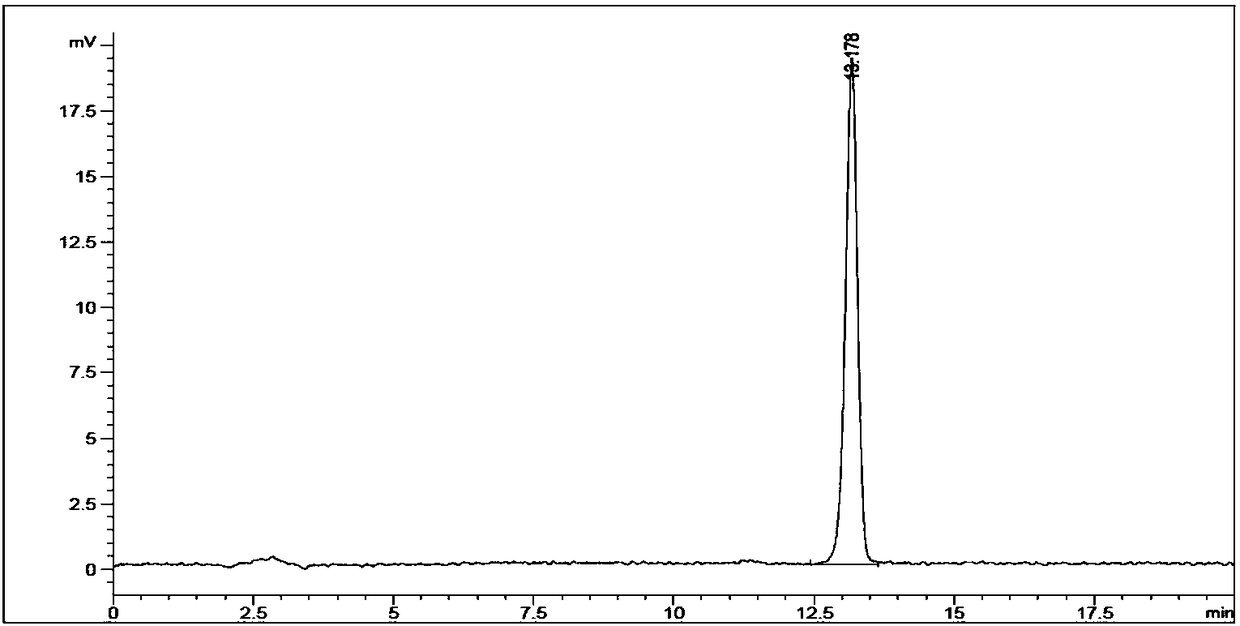Method for separating and extracting bomeol glycoside from Ophiopogon japonicus
A technology of borneolside and Ophiopogon japonicus is applied in the field of separation and purification of traditional Chinese medicines, which can solve the problems of successful extraction or synthesis without a reference substance of borneolside, and a way to purchase the reference substance without borneolside, etc., and achieves short cycle, low cost, Simple steps to operate
- Summary
- Abstract
- Description
- Claims
- Application Information
AI Technical Summary
Problems solved by technology
Method used
Image
Examples
Embodiment 1
[0025] Take 4 parts of 2 kg of Ophiopogon japonicus roots (underground part, collected according to the 2015 edition of the Chinese Pharmacopoeia) (the content of borneoside in the medicinal material is 0.013%, that is, 0.26g of borneoside), and extract them in the following ways, and calculate Extraction rate of borneoside:
[0026] ① Add 2kg of Ophiopogon japonicus roots, add 4L of 85% ethanol aqueous solution to reflux and extract 3 times, each time for 1 hour, keep slightly boiling, filter the medicinal residues, combine the extracts, detect by HPLC-ELSD method, the quality extraction rate is 89.3 %.
[0027] ② Add 2kg of Ophiopogon japonicus roots, add 8L of 85% ethanol aqueous solution to reflux and extract twice, each time for 2 hours, keep slightly boiling, filter the medicinal residues, combine the extracts, detect by HPLC-ELSD method, the quality extraction rate is 91.2 %.
[0028] ③ 2 kg of Ophiopogon japonicus roots, add 8 L of ethanol aqueous solution with volum...
Embodiment 2
[0032] Get 20kg of root tubers of Ophiopogon japonicus (medicinal material borneoside detection content is 0.014%, namely containing borneoside 2.8g), add 60L volume concentration 90% ethanol aqueous solution reflux extraction 2 times, each time 2 hours, keep slight boiling, Filter the medicinal residues and combine the extracts; after concentrating to alcohol-free (about 6L), add deionized water to 80L, mix well and then refrigerate at 2-10°C for 36 hours to precipitate and remove impurities, and take the supernatant and filter it through a plate containing activated carbon Obtain 75L of water-sinking liquid, then go to D101 macroporous resin (8L) to separate, use 80L deionized water and 25L volume concentration 20% ethanol aqueous solution, 25L volume concentration 30% ethanol aqueous solution, 30L volume concentration 40% ethanol aqueous solution as washing Deliquidation and segmental elution, in which ethanol eluents with different concentrations need 5L as a receiving port...
Embodiment 3
[0034]Get 200kg of root tubers of Ophiopogon japonicus (medicinal material borneoside detection content is 0.016%, promptly contain borneoside 32.0g), add 600L volume concentration 90% ethanol aqueous solution reflux extraction 3 times, the first, the second time each time 2 hour, the third time for 1 hour, keep slightly boiling, filter the dregs, and combine the extract; after concentrating until alcohol-free, add deionized water to 500L, mix well, and then refrigerate at 2-10°C for 24h to precipitate and remove impurities, take the above The clear liquid was filtered through a plate frame containing activated carbon to obtain 480L of water-sinking liquid, and then separated by D1400 macroporous resin (80L), followed by 800L deionized water and 250L volume concentration of 20% ethanol aqueous solution, 250L volume concentration of 30% ethanol aqueous solution, and 300L volume concentration Concentration of 40% ethanol aqueous solution is used as the eluent for segmental elutio...
PUM
 Login to View More
Login to View More Abstract
Description
Claims
Application Information
 Login to View More
Login to View More - R&D
- Intellectual Property
- Life Sciences
- Materials
- Tech Scout
- Unparalleled Data Quality
- Higher Quality Content
- 60% Fewer Hallucinations
Browse by: Latest US Patents, China's latest patents, Technical Efficacy Thesaurus, Application Domain, Technology Topic, Popular Technical Reports.
© 2025 PatSnap. All rights reserved.Legal|Privacy policy|Modern Slavery Act Transparency Statement|Sitemap|About US| Contact US: help@patsnap.com



